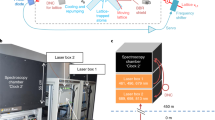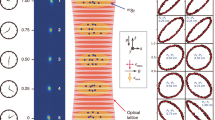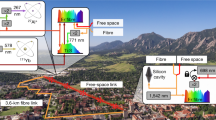Abstract
According to Einstein's theory of relativity, the passage of time changes in a gravitational field1,2. On Earth, raising a clock by 1 cm increases its apparent tick rate by 1.1 parts in 1018, allowing chronometric levelling3 through comparison of optical clocks1,4,5. Here, we demonstrate such geopotential measurements by determining the height difference of master and slave clocks separated by 15 km with an uncertainty of 5 cm. A subharmonic of the master clock laser is delivered through a telecom fibre6 to synchronously operate7 the distant clocks. Clocks operated under such phase coherence reject clock laser noise and facilitate proposals for linking clocks8,9 and interferometers10. Taken over half a year, 11 measurements determine the fractional frequency difference between the two clocks to be 1,652.9(5.9) × 10−18, consistent with an independent measurement by levelling and gravimetry11. Our system demonstrates a building block for an internet of clocks, which may constitute ‘quantum benchmarks’, serving as height references with dynamic responses.
This is a preview of subscription content, access via your institution
Access options
Subscribe to this journal
Receive 12 print issues and online access
$209.00 per year
only $17.42 per issue
Buy this article
- Purchase on Springer Link
- Instant access to full article PDF
Prices may be subject to local taxes which are calculated during checkout




Similar content being viewed by others
References
Chou, C. W., Hume, D. B., Rosenband, T. & Wineland, D. J. Optical clocks and relativity. Science 329, 1630–1633 (2010).
Pound, R. V. & Rebka, G. A. Jr Apparent weight of photons. Phys. Rev. Lett. 4, 337–341 (1960).
Vermeer, M. Chronometric levelling. Rep. Finnish Geodetic Inst. 83, 1–7 (1983).
Bloom, B. J. et al. An optical lattice clock with accuracy and stability at the 10−18 level. Nature 506, 71–75 (2014).
Ushijima, I., Takamoto, M., Das, M., Ohkubo, T. & Katori, H. Cryogenic optical lattice clocks. Nature Photon. 9, 185–189 (2015).
Akatsuka, T. et al. 30-km-long optical fiber link at 1397 nm for frequency comparison between distant strontium optical lattice clocks. Jpn. J. Appl. Phys. 53, 032801 (2014).
Takamoto, M., Takano, T. & Katori, H. Frequency comparison of optical lattice clocks beyond the Dick limit. Nature Photon. 5, 288–292 (2011).
Chou, C. W., Hume, D. B., Thorpe, M. J., Wineland, D. J. & Rosenband, T. Quantum coherence between two atoms beyond Q = 1015. Phys. Rev. Lett. 106, 160801 (2011).
Polzik, E. S. & Ye, J. Entanglement and spin squeezing in a network of distant optical lattice clocks. Phys. Rev. A 93, 021404(R) (2016).
Graham, P. W., Hogan, J. M., Kasevich, M. A. & Rajendran, S. New method for gravitational wave detection with atomic sensors. Phys. Rev. Lett. 110, 171102 (2013).
Vanicek, P., Castle, R. O. & Balazs, E. I. Geodetic leveling and its applications. Rev. Geophys. 18, 505–524 (1980).
Riehle, F. Towards a redefinition of the second based on optical atomic clocks. C. R. Phys. 16, 506–515 (2015).
Newbury, N. R., Williams, P. A. & Swann, W. C. Coherent transfer of an optical carrier over 251 km. Opt. Lett. 32, 3056–3058 (2007).
Fujieda, M. et al. Carrier-phase two-way satellite frequency transfer over a very long baseline. Metrologia 51, 253–262 (2014).
Ludlow, A. D. et al. Sr lattice clock at 1 × 10−16 fractional uncertainty by remote optical evaluation with a Ca clock. Science 319, 1805–1808 (2008).
Yamaguchi, A. et al. Direct comparison of distant optical lattice clocks at the 10−16 uncertainty. Appl. Phys. Exp. 4, 082203 (2011).
Calonico, D. et al. High-accuracy coherent optical frequency transfer over a doubled 642-km fiber link. Appl. Phys. B 117, 979–986 (2014).
Chiodo, N. et al. Cascaded optical fiber link using the internet network for remote clocks comparison. Opt. Express 23, 33927–33937 (2015).
Raupach, S. M. F., Koczwara, A. & Grosche, G. Brillouin amplification supports 1×10−20 uncertainty in optical frequency transfer over 1400 km of underground fiber. Phys. Rev. A 92, 021801(R) (2015).
Lisdat, C. et al. A clock network for geodesy and fundamental science. Preprint at http://arxiv.org/abs/1511.07735 (2015).
Poli, N. et al. A transportable strontium optical lattice clock. Appl. Phys. B 117, 1107–1116 (2014).
Santarelli, G. et al. Frequency stability degradation of an oscillator slaved to a periodically interrogated atomic resonator. IEEE Trans. Ultrason. Ferroelectr. Freq. Control 45, 887–894 (1998).
Katori, H. Optical lattice clocks and quantum metrology. Nature Photon. 5, 203–210 (2011).
Leibrandt, D. R., Thorpe, M. J., Bergquist, J. C. & Rosenband, T. Field-test of a robust, portable, frequency-stable laser. Opt. Express 19, 10278–10286 (2011).
Hafner, S. et al. 8 × 10−17 fractional laser frequency instability with a long room-temperature cavity. Opt. Lett. 40, 2112–2115 (2015).
Kessler, T. et al. A sub-40-mHz-linewidth laser based on a silicon single-crystal optical cavity. Nature Photon. 6, 687–692 (2012).
Terra, O., Grosche, G. & Schnatz, H. Brillouin amplification in phase coherent transfer of optical frequencies over 480 km fiber. Opt. Express 18, 16102–16111 (2010).
Katori, H., Ovsiannikov, V. D., Marmo, S. I. & Palchikov, V. G. Strategies for reducing the light shift in atomic clocks. Phys. Rev. A 91, 052503 (2015).
Bondarescu, R. et al. Ground-based optical atomic clocks as a tool to monitor vertical surface motion. Geophys. J. Int. 202, 1770–1774 (2015).
Derevianko, A. & Pospelov, M. Hunting for topological dark matter with atomic clocks. Nature Phys. 10, 933–936 (2014).
Munekane, H. & Boehm, J. Numerical simulation of troposphere-induced errors in GPS-derived geodetic time series over Japan. J. Geod. 84, 405–417 (2010).
Hall, J., Long-Sheng, M. & Kramer, G. Principles of optical phase-locking: application to internal mirror He-Ne lasers phase-locked via fast control of the discharge current. IEEE J. Quant. Electron. 23, 427–437 (1987).
Williams, P. A., Swann, W. C. & Newbury, N. R. High-stability transfer of an optical frequency over long fiber-optic links. J. Opt. Soc. Am. B 25, 1284–1293 (2008).
Musha, M., Hong, F.-L., Nakagawa, K. & Ueda, K. Coherent optical frequency transfer over 50-km physical distance using a 120-km-long installed telecom fiber network. Opt. Express 16, 16459–16466 (2008).
Chigusa, Y. et al. Low-loss pure-silica-core fibers and their possible impact on transmission systems. J. Lightwave Technol. 23, 3541–3355 (2005).
Tamura, Y. A computer program for calculating the tide-generating force. Publ. Int. Lat. Obs. Mizusawa 16, 1–20 (1982).
Agnew, D. C. SPOTL: Some Programs for Ocean-Tide Loading (Scripps Institution of Oceanography, 2013).
Tamura, Y. A harmonic development of the tide-generating potential. Bull. Inf. Marées Terrestres 99, 6813–6855 (1987).
Cheng, Y. & Andersen, O. B. Multimission empirical ocean tide modeling for shallow waters and polar seas. J. Geophys. Res. Oceans 116, C11001 (2011).
Matsumoto, K., Takanezawa, T. & Ooe, M. Ocean tide models developed by assimilating TOPEX/POSEIDON altimeter data into hydrodynamical model: a global model and a regional model around Japan. J. Oceanogr. 56, 567–581 (2000).
Goodkind, J. M. Test of theoretical solid earth and ocean gravity tides. Geophys. J. Int. 125, 106–114 (1996).
Stammer, D. et al. Accuracy assessment of global barotropic ocean tide models. Rev. Geophys. 52, 243–282 (2014).
Irwan, M., Kimata, F. & Fujii, N. Time dependent modeling of magma intrusion during the early stage of the 2000 Miyakejima activity. J. Volcan. Geotherm. Res. 150, 202–212 (2006).
Ohta, Y., Kimata, F. & Sagiya, T. Reexamination of the interplate coupling in the Tokai region, central Japan, based on the GPS data in 1997–2002. Geophys. Res. Lett. 31, L24604 (2004).
Yokota, Y. & Koketsu, K. A very long-term transient event preceding the 2011 Tohoku earthquake. Nature Commun. 6, 5934 (2015).
Acknowledgements
This work is partially supported by the Japan Society for the Promotion of Science through its Funding Program for World-Leading Innovative R&D on Science and Technology Program and by the Photon Frontier Network Program of the Ministry of Education, Culture, Sports, Science and Technology, Japan. The authors thank M. Das for the development of cryogenic clocks, N. Nemitz and K. Gibble for careful reading of the manuscript and for useful comments, and M. Musha for the loan of a phase-locked loop circuit for the clock laser.
Author information
Authors and Affiliations
Contributions
T.T., M.T. and I.U. operated the clocks at UTokyo and RIKEN and analysed data. T.A. and A.Y. were responsible for the fibre link and M.T. and N.O. for the clock lasers. Y.K. evaluated the tidal perturbation. B.M. supervised the spirit-levelling measurements. Y.K., B.M., H.M. and H.K. discussed the geodetic applications of a quantum benchmark. T.T., Y.K. and H.K. wrote the manuscript. H.K. planned and supervised the experiments. All authors discussed the results and commented on the manuscript.
Corresponding author
Ethics declarations
Competing interests
The authors declare no competing financial interests.
Rights and permissions
About this article
Cite this article
Takano, T., Takamoto, M., Ushijima, I. et al. Geopotential measurements with synchronously linked optical lattice clocks. Nature Photon 10, 662–666 (2016). https://doi.org/10.1038/nphoton.2016.159
Received:
Accepted:
Published:
Issue Date:
DOI: https://doi.org/10.1038/nphoton.2016.159
This article is cited by
-
A lab-based test of the gravitational redshift with a miniature clock network
Nature Communications (2023)
-
Optical-referenceless optical frequency counter with twelve-digit absolute accuracy
Scientific Reports (2023)
-
Differential clock comparisons with a multiplexed optical lattice clock
Nature (2022)
-
Comparing ultrastable lasers at 7 × 10−17 fractional frequency instability through a 2220 km optical fibre network
Nature Communications (2022)
-
Point-to-point stabilized optical frequency transfer with active optics
Nature Communications (2021)



